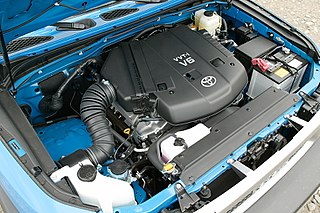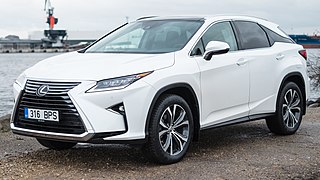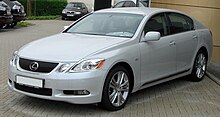
Lexus is the luxury vehicle division of the Japanese automaker Toyota Motor Corporation. The Lexus brand is marketed in more than 90 countries and territories worldwide and is Japan's largest-selling make of premium cars. It has ranked among the 10 largest Japanese global brands in market value. Lexus is headquartered in Nagoya, Japan. Operational centers are located in Brussels, Belgium, and Plano, Texas, United States.

Electronic stability control (ESC), also referred to as electronic stability program (ESP) or dynamic stability control (DSC), is a computerized technology that improves a vehicle's stability by detecting and reducing loss of traction (skidding). When ESC detects loss of steering control, it automatically applies the brakes to help steer the vehicle where the driver intends to go. Braking is automatically applied to wheels individually, such as the outer front wheel to counter oversteer, or the inner rear wheel to counter understeer. Some ESC systems also reduce engine power until control is regained. ESC does not improve a vehicle's cornering performance; instead, it helps reduce the chance of the driver losing control of the vehicle.

The Lexus GS is an executive car sold by Lexus, the premium division of Toyota. The same car had been launched in 1991 as the Toyota Aristo in Japan. For non-Japanese markets, it was released as the Lexus GS in February 1993. It continued using the Toyota Aristo name for the Japanese market until January 2005.
Hybrid Synergy Drive (HSD), also known as Toyota Hybrid System II, is the brand name of Toyota Motor Corporation for the hybrid car drive train technology used in vehicles with the Toyota and Lexus marques. First introduced on the Prius, the technology is an option on several other Toyota and Lexus vehicles and has been adapted for the electric drive system of the hydrogen-powered Mirai, and for a plug-in hybrid version of the Prius. Previously, Toyota also licensed its HSD technology to Nissan for use in its Nissan Altima Hybrid. Its parts supplier Aisin Seiki Co. offers similar hybrid transmissions to other car companies.

The Toyota GR engine family is a gasoline, open-deck, piston V6 engine series. The GR series has a 60° die-cast aluminium block and aluminium DOHC cylinder heads. This engine series also features 4 valves per cylinder, forged steel connecting rods and crankshaft, one-piece cast camshafts, a timing chain, and a cast aluminium lower intake manifold. Some variants use multi-port fuel injection, some have D4 direct injection, and others have a combination of direct injection and multi-port fuel injection or D4-S.

The Lexus GX is a mid/full-size luxury SUV sold in North American and Eurasian markets by Lexus, a luxury division of Toyota. The GX is based on the Toyota Land Cruiser Prado, from which it derives its off-road capability. Lexus introduced the first generation, known as the GX 470 in 2002, and subsequently became the third SUV to enter the Lexus lineup. A full-time four-wheel drive system is standard with low-range gearing. The 4.7-liter V8 engine in the GX 470 was the same as used on the larger LX 470. The firm next introduced the second-generation model in 2009, badged GX 460 to reflect the switch to a 4.6-liter V8 engine. Lexus later released a lower displacement GX 400 in 2012 for the Chinese market, with a 4.0-liter V6 engine. The third-generation model introduced in 2023 uses the GX 550 moniker with a twin-turbocharged 3.4-liter V6 engine and GX 550h with a turbocharged hybrid electric 2.4-liter four-cylinder engine.

The Toyota Highlander, also known as the Toyota Kluger, is a mid-size crossover SUV with three-row seating produced by Toyota since 2000.

The driver monitoring system, also known as driver attention monitor, is a vehicle safety system to assess the driver's alertness and warn the driver if needed and eventually apply the brakes. It was first introduced by Toyota in 2006 for its and Lexus' latest models. It was first offered in Japan on the GS 450h. The system's functions co-operate with the pre-collision system (PCS). The system uses infrared sensors to monitor driver attentiveness. Specifically, the driver monitoring system includes a CCD camera placed on the steering column which tracks the face, via infrared LED detectors. If the driver is not paying attention to the road ahead and a dangerous situation is detected, the system will warn the driver by flashing lights, warning sounds. If no action is taken, the vehicle will apply the brakes. This system is said to be the first of its kind.

A collision avoidance system (CAS), also known as a pre-crash system, forward collision warning system (FCW), or collision mitigation system, is an advanced driver-assistance system designed to prevent or reduce the severity of a collision. In its basic form, a forward collision warning system monitors a vehicle's speed, the speed of the vehicle in front of it, and the distance between the vehicles, so that it can provide a warning to the driver if the vehicles get too close, potentially helping to avoid a crash. Various technologies and sensors that are used include radar (all-weather) and sometimes laser (LIDAR) and cameras to detect an imminent crash. GPS sensors can detect fixed dangers such as approaching stop signs through a location database. Pedestrian detection can also be a feature of these types of systems.

The Toyota Crown Majesta is a full-size luxury sedan from Toyota. It is an upmarket variant of the Crown and serves as Toyota's flagship model in various countries.

Remote Touch is a vehicle interface system present in some Lexus cars for use in conjunction with in-car information, configuration, and entertainment systems. The Remote Touch controller, which is similar to a computer mouse or joystick, allows the driver to operate an on-screen cursor on the vehicle's GPS navigation system screen.

The Lexus LS (XF40) is the fourth generation of the Lexus LS line of full-size luxury sedans. Lexus debuted the model line at the 2006 North American International Auto Show, with variants including the standard wheelbase LS 460 (USF40) and long wheelbase LS 460 L (USF41); the chassis codes (USF40/USF41) are derived from the fourth generation XF40 platform code and UR series engine designation. In development from 2001, the final design was selected for the V8 models in late 2003, with the hybrid variant's design finalized in 2004. Introduced at the 2006 New York International Auto Show, all-wheel drive hybrid models, the standard wheelbase LS 600h (UVF45) and long wheelbase LS 600h L (UVF46), joined the lineup in the 2008 model year. The LS 460 and LS 460 L models feature a 4.6 L UR series V8 and an 8-speed automatic transmission, while hybrid models are powered by a 5.0 L UR series V8 engine equipped with electric motors, with a continuously variable transmission and all-wheel drive. All-wheel drive versions of the non-hybrid LS 460 (USF45) and LS 460 L (USF46) models were introduced at the 2008 Moscow International Automobile Salon. The XF40 received updates for the 2010 and 2013 model years.

Electronically controlled brake (ECB) developed by Toyota Motor Corporation initially for its hybrid and Lexus models, is the world's first production brake-by-wire braking system. The ECB went on sale in Japan in June 2001, first appearing on the Toyota Estima hybrid, and making its North American debut with the launch of the Lexus RX 400h SUV in April 2005. The ECB is an integral part of the company's Vehicle Dynamics Integrated Management stability control system, by allowing for automatic brake adjustments, which work in conjunction with variable gear-ratio electric power steering systems.

Active Power Stabilizer Suspension System (APSSS), is an electric active suspension system with active anti-roll bars developed by Toyota Motor Corporation for its high-end vehicles including Lexus models. By altering stabilizer bar stiffness, this system acts to reduce body tilt during cornering, keeping the vehicle more level during turns and improving handling, as opposed to the natural tendency of a vehicle to roll due to the lateral forces experienced during high-speed maneuvering. The active stabilizer system relies on vehicle body sensors and electric motors. The first production usage of this system was introduced in August 2005 with the Lexus GS430 sport sedan, followed by the 2008 Lexus LS 600h luxury sedan. The development of APSSS is claimed to be the world's first electric active stabilizer system. It is a system improvement of an earlier Toyota technology called Toyota TEMS (Toyota Electronic Modulated Suspension).

The Lexus CT is a hybrid electric automobile sold Lexus, a luxury division of Toyota, as a premium compact hatchback. The CT, consisting of a single model called the CT 200h, is a luxury hybrid based on the Toyota Prius drivetrain and Toyota MC platform chassis, and is the first luxury compact and hatchback hybrid. It is the first production model in Lexus's family to introduce the "Spindle Grille" design as seen in its fascia. It made its debut at the March 2010 Geneva International Motor Show, six months after the unveiling of the LF-Ch concept car; it is primarily targeted at the European market but is being sold worldwide and was introduced to North American markets at the April 2010 New York International Auto Show. Lexus has trademarked the names CT 200h, CT 300h, and CT 400h. The design by Takeshi Tanabe was approved in 2008 and patented on 11 September 2009.

The Lexus GS (S190) is the third generation of the Lexus GS line of executive cars. Sold by Lexus since 2005, the line includes multiple V6, V8, and hybrid models. A concept model for the GS line, the LF-S, debuted in late 2003 at the Tokyo Motor Show. The third generation GS first appeared as a pre-production vehicle at the 2004 North American International Auto Show in Detroit with the production version being shown a year later at the 2005 show. The initial lineup featured V6 and V8 engines with rear-wheel drive, and for the first time on a Lexus sedan, the option of all-wheel drive with the V6-powered GS 300 and GS 350 models. The GS 450h performance hybrid joined the lineup in 2006.

The Lexus RX is a luxury crossover SUV sold since 1998 by Lexus, a luxury division of Toyota. Originally released in its home market of Japan in late 1997 as the Toyota Harrier, export sales began in March 1998 as the Lexus RX. Considered as the first luxury crossover SUV, five generations of the RX have been produced to date, the first being compact in size, and the latter three classified as mid-size. Both front- and four-wheel drive configurations have been used on the RX series, and several gasoline powertrain options, including V6 engines and hybrid systems, have been offered. In the Lexus model lineup, the RX sits below the larger Lexus LX, and above the shorter and less wider, but taller GX SUV. The name "RX" stands for "Radiant Crossover". It has also been labelled as "Recreational Cross Country" in some markets. The RX's current Toyota counterpart is the Highlander/Kluger; past counterparts included the Harrier and Venza.

The Lexus RX (AL20) is the fourth generation of the Lexus RX range of mid-size luxury crossover SUVs produced by luxury marque Lexus, a luxury division of Japanese brand Toyota. Sold by the brand from 2015 to 2022, the range includes straight-four and V6 engines.

The Dynamic Force engines are a family of internal combustion engines developed by Toyota under the brand's Toyota New Global Architecture (TNGA) strategy. The engines can be fueled by petrol (gasoline) or ethanol and can be combined with electric motors in a hybrid drivetrain. The engines were developed alongside the TNGA family of vehicle platforms, as part of a company-wide effort to simplify the vehicles being produced by Toyota.


















